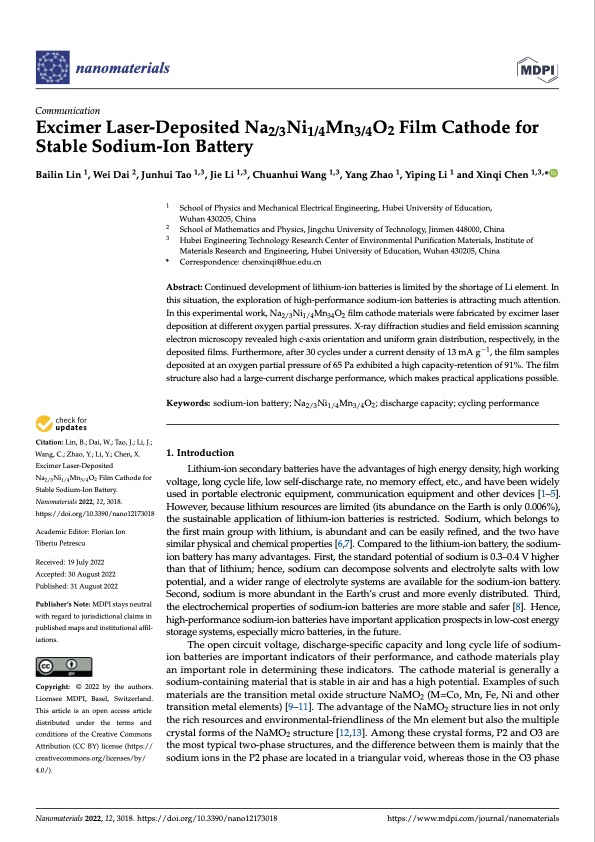
PDF Publication Title:
Text from PDF Page: 001
nanomaterials Communication Excimer Laser-Deposited Na2/3Ni1/4Mn3/4O2 Film Cathode for Stable Sodium-Ion Battery Bailin Lin 1, Wei Dai 2, Junhui Tao 1,3, Jie Li 1,3, Chuanhui Wang 1,3, Yang Zhao 1, Yiping Li 1 and Xinqi Chen 1,3,* 1 2 3 * Correspondence: chenxinqi@hue.edu.cn Abstract: Continued development of lithium-ion batteries is limited by the shortage of Li element. In this situation, the exploration of high-performance sodium-ion batteries is attracting much attention. In this experimental work, Na2/3Ni1/4Mn34O2 film cathode materials were fabricated by excimer laser deposition at different oxygen partial pressures. X-ray diffraction studies and field emission scanning electron microscopy revealed high c-axis orientation and uniform grain distribution, respectively, in the deposited films. Furthermore, after 30 cycles under a current density of 13 mA g−1, the film samples deposited at an oxygen partial pressure of 65 Pa exhibited a high capacity-retention of 91%. The film structure also had a large-current discharge performance, which makes practical applications possible. Keywords: sodium-ion battery; Na2/3Ni1/4Mn3/4O2; discharge capacity; cycling performance 1. Introduction Lithium-ion secondary batteries have the advantages of high energy density, high working voltage, long cycle life, low self-discharge rate, no memory effect, etc., and have been widely used in portable electronic equipment, communication equipment and other devices [1–5]. However, because lithium resources are limited (its abundance on the Earth is only 0.006%), the sustainable application of lithium-ion batteries is restricted. Sodium, which belongs to the first main group with lithium, is abundant and can be easily refined, and the two have similar physical and chemical properties [6,7]. Compared to the lithium-ion battery, the sodium- ion battery has many advantages. First, the standard potential of sodium is 0.3–0.4 V higher than that of lithium; hence, sodium can decompose solvents and electrolyte salts with low potential, and a wider range of electrolyte systems are available for the sodium-ion battery. Second, sodium is more abundant in the Earth’s crust and more evenly distributed. Third, the electrochemical properties of sodium-ion batteries are more stable and safer [8]. Hence, high-performance sodium-ion batteries have important application prospects in low-cost energy storage systems, especially micro batteries, in the future. The open circuit voltage, discharge-specific capacity and long cycle life of sodium- ion batteries are important indicators of their performance, and cathode materials play an important role in determining these indicators. The cathode material is generally a sodium-containing material that is stable in air and has a high potential. Examples of such materials are the transition metal oxide structure NaMO2 (M=Co, Mn, Fe, Ni and other transition metal elements) [9–11]. The advantage of the NaMO2 structure lies in not only the rich resources and environmental-friendliness of the Mn element but also the multiple crystal forms of the NaMO2 structure [12,13]. Among these crystal forms, P2 and O3 are the most typical two-phase structures, and the difference between them is mainly that the sodium ions in the P2 phase are located in a triangular void, whereas those in the O3 phase School of Physics and Mechanical Electrical Engineering, Hubei University of Education, Wuhan 430205, China School of Mathematics and Physics, Jingchu University of Technology, Jinmen 448000, China Hubei Engineering Technology Research Center of Environmental Purification Materials, Institute of Materials Research and Engineering, Hubei University of Education, Wuhan 430205, China Citation: Lin, B.; Dai, W.; Tao, J.; Li, J.; Wang, C.; Zhao, Y.; Li, Y.; Chen, X. Excimer Laser-Deposited Na2/3Ni1/4Mn3/4O2 Film Cathode for Stable Sodium-Ion Battery. Nanomaterials 2022, 12, 3018. https://doi.org/10.3390/nano12173018 Academic Editor: Florian Ion Tiberiu Petrescu Received: 19 July 2022 Accepted: 30 August 2022 Published: 31 August 2022 Publisher’s Note: MDPI stays neutral with regard to jurisdictional claims in published maps and institutional affil- iations. Copyright: © 2022 by the authors. Licensee MDPI, Basel, Switzerland. This article is an open access article distributed under the terms and conditions of the Creative Commons Attribution (CC BY) license (https:// creativecommons.org/licenses/by/ 4.0/). Nanomaterials 2022, 12, 3018. https://doi.org/10.3390/nano12173018 https://www.mdpi.com/journal/nanomaterialsPDF Image | xcimer Laser-Deposited Na Film Cathode Sodium-Ion Battery

PDF Search Title:
xcimer Laser-Deposited Na Film Cathode Sodium-Ion BatteryOriginal File Name Searched:
nanomaterials-12-03018.pdfDIY PDF Search: Google It | Yahoo | Bing
Salgenx Redox Flow Battery Technology: Salt water flow battery technology with low cost and great energy density that can be used for power storage and thermal storage. Let us de-risk your production using our license. Our aqueous flow battery is less cost than Tesla Megapack and available faster. Redox flow battery. No membrane needed like with Vanadium, or Bromine. Salgenx flow battery
| CONTACT TEL: 608-238-6001 Email: greg@salgenx.com | RSS | AMP |